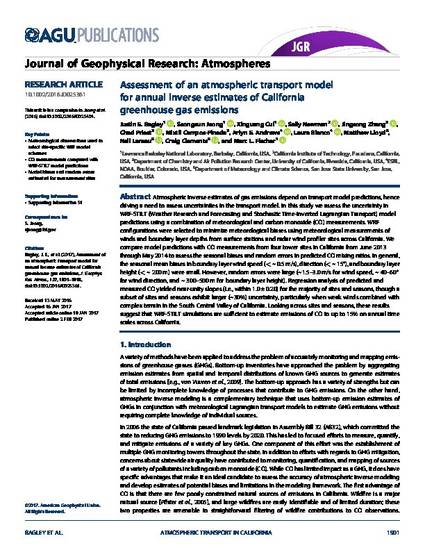
Article
Assessment of an atmospheric transport model for annual inverse estimates of California greenhouse gas emissions
Journal of Geophysical Research: Atmospheres
(2017)
Abstract
Atmospheric inverse estimates of gas emissions depend on transport model predictions, hence driving a need to assess uncertainties in the transport model. In this study we assess the uncertainty in WRF-STILT (Weather Research and Forecasting and Stochastic Time-Inverted Lagrangian Transport) model predictions using a combination of meteorological and carbon monoxide (CO) measurements. WRF configurations were selected to minimize meteorological biases using meteorological measurements of winds and boundary layer depths from surface stations and radar wind profiler sites across California. We compare model predictions with CO measurements from four tower sites in California from June 2013 through May 2014 to assess the seasonal biases and random errors in predicted CO mixing ratios. In general, the seasonal mean biases in boundary layer wind speed (< ~ 0.5 m/s), direction (< ~ 15°), and boundary layer height (< ~ 200 m) were small. However, random errors were large (~1.5–3.0 m/s for wind speed, ~ 40–60° for wind direction, and ~ 300–500 m for boundary layer height). Regression analysis of predicted and measured CO yielded near-unity slopes (i.e., within 1.0 ± 0.20) for the majority of sites and seasons, though a subset of sites and seasons exhibit larger (~30%) uncertainty, particularly when weak winds combined with complex terrain in the South Central Valley of California. Looking across sites and seasons, these results suggest that WRF-STILT simulations are sufficient to estimate emissions of CO to up to 15% on annual time scales across California.
Disciplines
Publication Date
February 16, 2017
DOI
10.1002/2016JD025361
Publisher Statement
© Copyright 2017 American Geophysical Union. All rights reserved.
This article was published in the Journal of Geophysical Research: Atmospheres, volume 122, issue 3, 2017, and can be found online at the following link: http://dx.doi.org/10.1002/2016JD025361.
Citation Information
Justin E. Bagley, Seongeun Jeong, Xinguang Cui, Sally Newman, et al.. "Assessment of an atmospheric transport model for annual inverse estimates of California greenhouse gas emissions" Journal of Geophysical Research: Atmospheres Vol. 122 Iss. 3 (2017) p. 1901 - 1918 ISSN: 2169-897X Available at: http://works.bepress.com/craig_clements/37/
